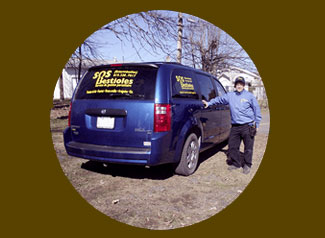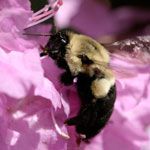How to recognize Wasp Species?
Paper Wasp
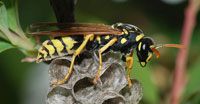
The Paper Wasp is quite long, it measures 1.5-2 cm long. Its body is thin and elongated and hairyless. The Paper Wasp legs are longer than for the other species. When the Paper Wasp is flying, its legs are dragging behind. The Paper Wasp has a slow and clumsy flight.
Blackjacket Wasp
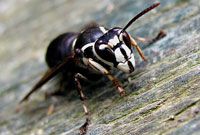
Dolichovespula maculata is one of our biggest social wasp. It measures 2-2.5 cm and its abdomen can be 10 mm wide. The Blackjacket Wasp is black with whitish bands on its head, thorax and abdomen. Bands can also have a very light green colour. It is a hairyless wasp.
Yellojacket Wasp
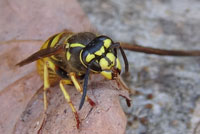
Vespula spp is small. It is about the size of a bee and that’s why they are often confused with one another. The domestic bee has lots of hair, it is calm and non-agressive. The Yellojacket Wasp is agressive. The Yellojacket Wasp can sting several times if threatened.
What are the risk for me and my belongings?
Wasps do not cause structural damage per se but one might have to do renovations after removing a structural nest.
Wasps are social insects and are very useful. They hunt other insects. Bumblebees and domestic bees gather nectar from flowers.
The sting of a wasp is painful. There is a risk of severe allergic reaction, especially if there is more than one sting and if it is Yellowjacket Wasps. The location and size of the nest will determine the risk level for you and your family.
The Yellowjacket Wasp builds its nest underground, under a patio tile, the hedge, the siding of a house, etc. The Yellowjacket Wasp can use rodents’ burrows. The Yellowjacket Wasp is very agressive and it can sting several times. The Yellowjacket Wasp gets nervous if one gets too close to the nest.
Call an expert Ask an expert » Get a quick quote »What are the signs of the Wasp presence?
One can notice frequent Wasp activity, flying around. You may see the nest or hear their humming. Wasps that come close to us are probably checking if we are a threat to them. This can be an indicator that the nest is nearby.
- There are three types of nest : underground, visible and suspended (umbrella or ball shape) and structural (non visible, hidden in walls, attick).
- Wasp uses material (wood, mud) specific to its specie. Most wasps who have paper type of nest will use wood. They will pick up wood fibres from a deck, fence. You can see bits of colour on the nest, depending upon where they took the wood from. Wasp use their saliva to make a wood paste and build the nest.
- In general, Yellowjackets will not build their nest in full sun, they prefer the shade. At first, the nest is about the size of a tennis ball. The Blackjacket Wasp nest has the shape of a football ball with several aeration holes. The nest of the Paper Wasp has the shape of an umbrella. The nest is open, there is no paper cover. One can see directly the wasps and alveoli.
- Hearing a humming sound behind a wall could indicate a structural nest. Those structural nest are often made by Yellowjacket wasps or by bumblebees.
- Bumblebees produce honey and wax but not wasps. In summer, if you observe sweet honey colours, it is not a bees nor wasps’ nest but in fact it is a bumblebees' nest.
- Domestic bees’ hives are very rare since they cannot survive our winter. Domestic bees come from an apiary. Domestic bees are protected by law. No harm should be made to bees. If you find a domestic bees’ hive, call us. We will come with a beekeeper who will safely put them in a hive.
SOS Bugs can detect wasps and bumble bees’ nests hidden inside walls, by using infrared thermal imaging.
Call an expert Ask an expert » Get a quick quote »What should I do if I have a wasp nest?
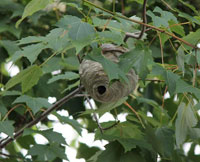 First, don’t get too close to the nest. The entrance of the nest is always under the surveillance of a douzen wasps. The bigger the nest is, the further away you need to be.
First, don’t get too close to the nest. The entrance of the nest is always under the surveillance of a douzen wasps. The bigger the nest is, the further away you need to be.
Do not try to take the wasps’ nest away with the water hose. It will not kill them, instead, you will get them angry. Wasps will fix the nest afterwards. Burning a nest is not an option either because of the fire risk, especially if it fixed to a building or when it is a hot and dry weather period. There is also the risk of being stung and falling off the ladder.
Nests get bigger as the Summer season progresses. A wasps’ nest can have hundreds of wasps, which can all sting, more than one. Think about it seriously when thinking of getting rid of the nest yourself. Do you know if you or your family members are allergic to wasps’ venom, is there a hospital nearby? It is safer to call and leave it to a pest control expert.
SOS Bugs will safely remove the nest and destroy the colony for you. There is a specific time of the day and tecnic to be done, to make sure that the wasps don’t come back.
Call an expert Ask an expert » Get a quick quote »

